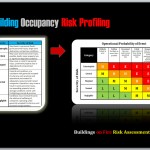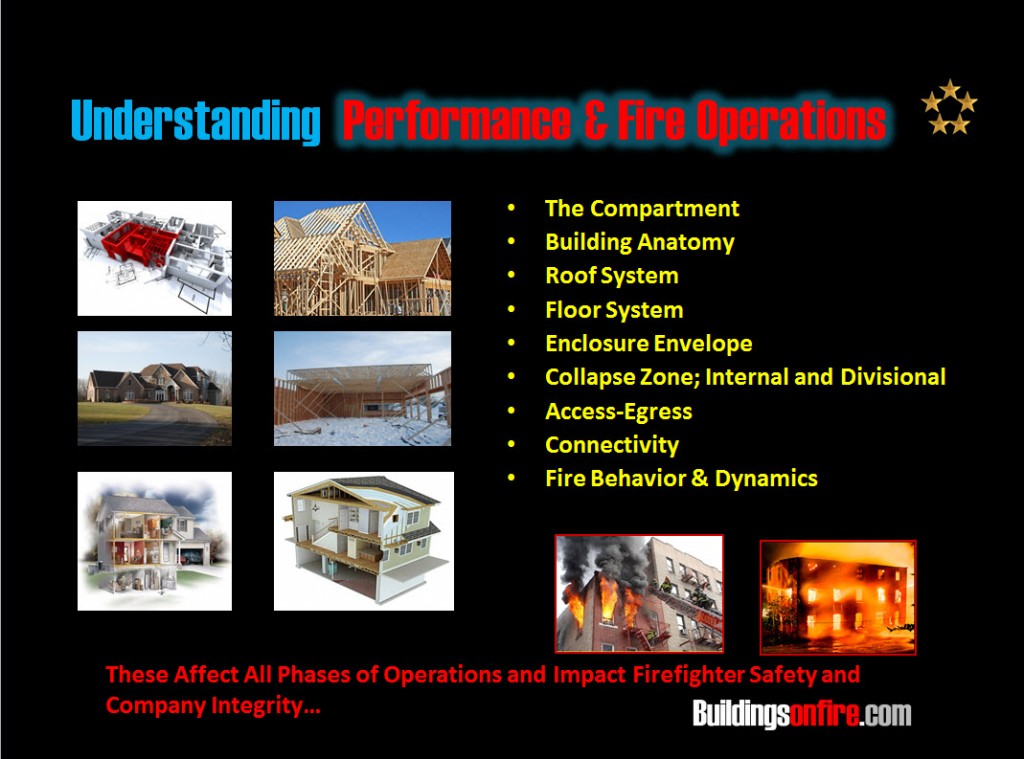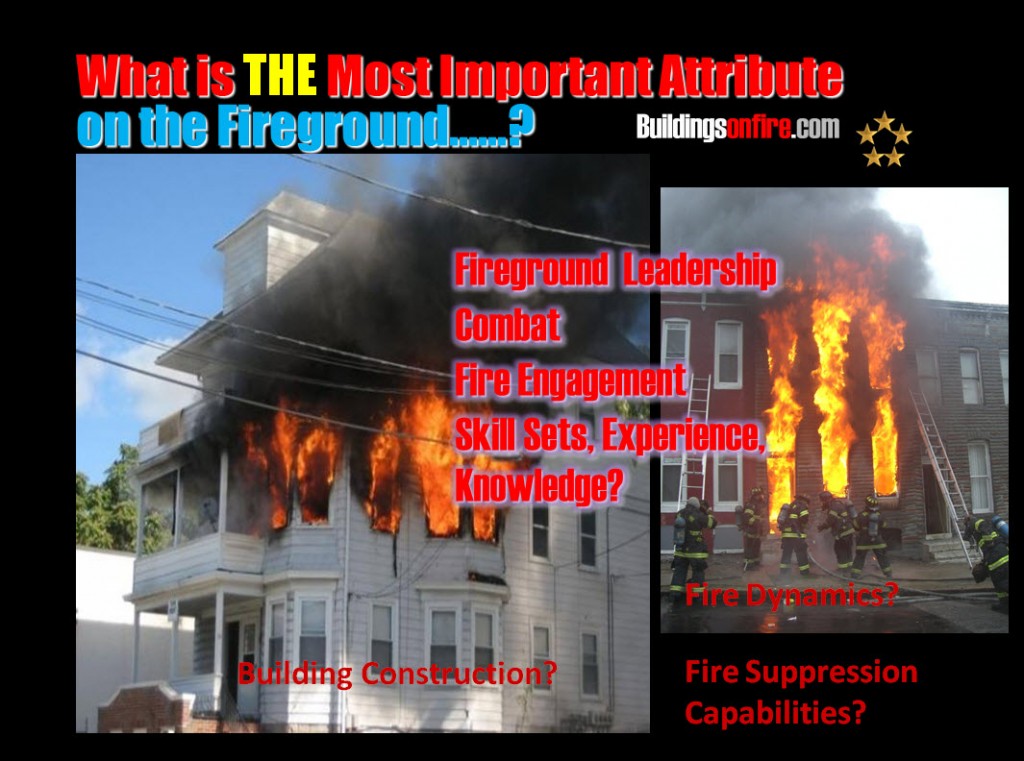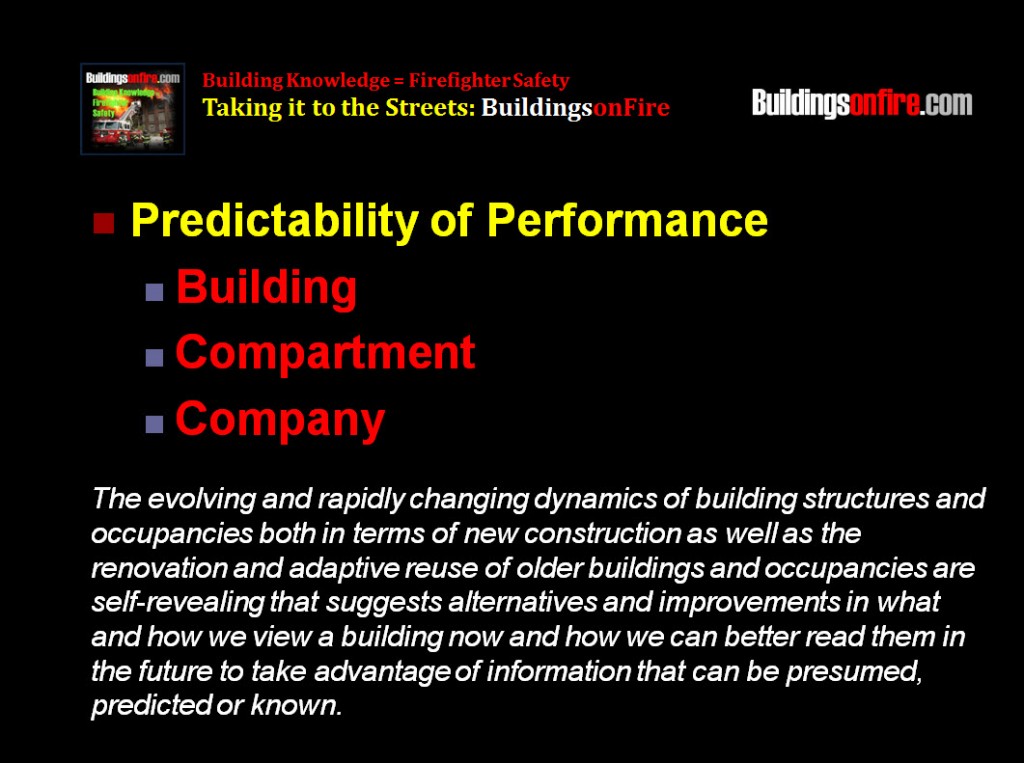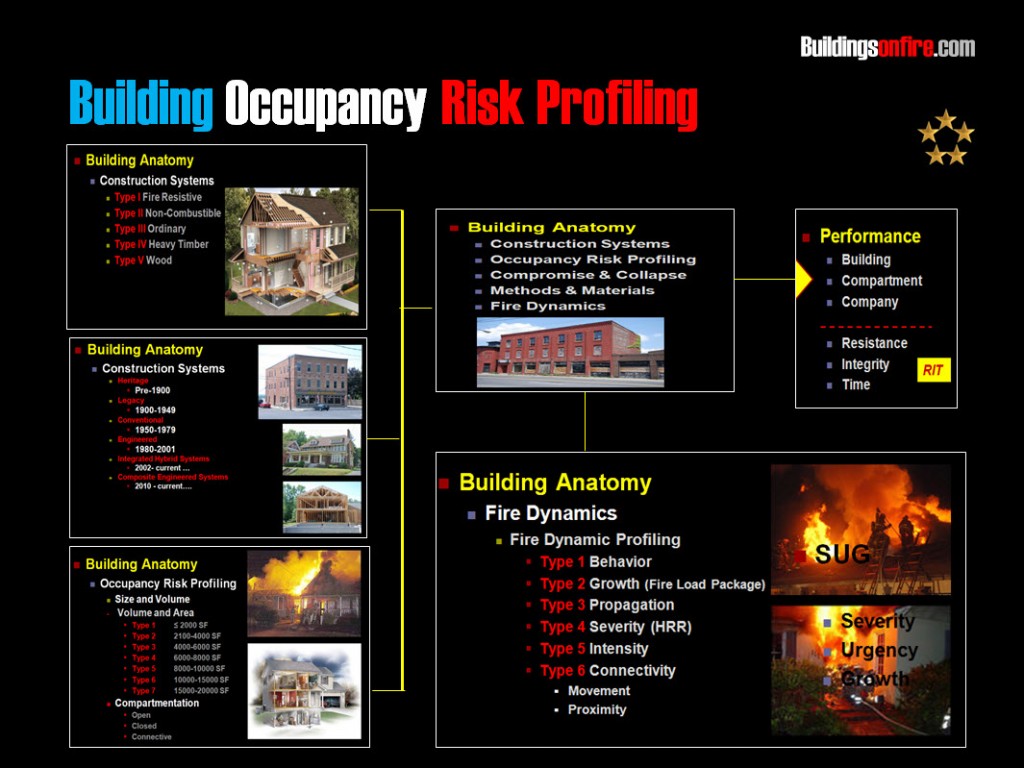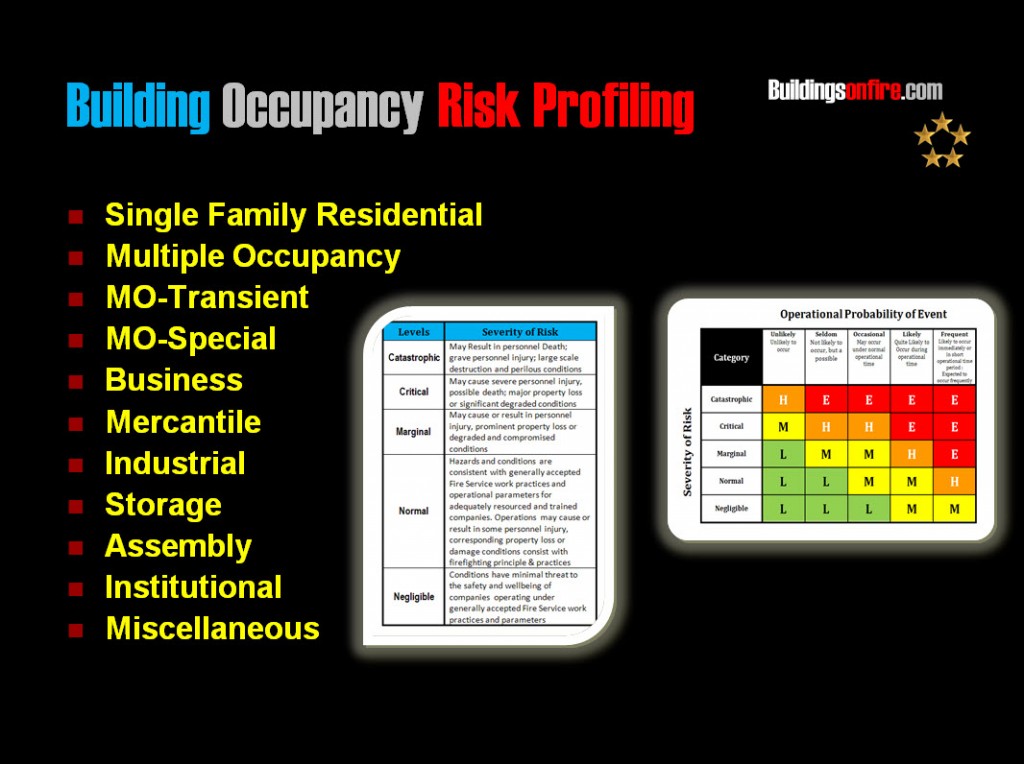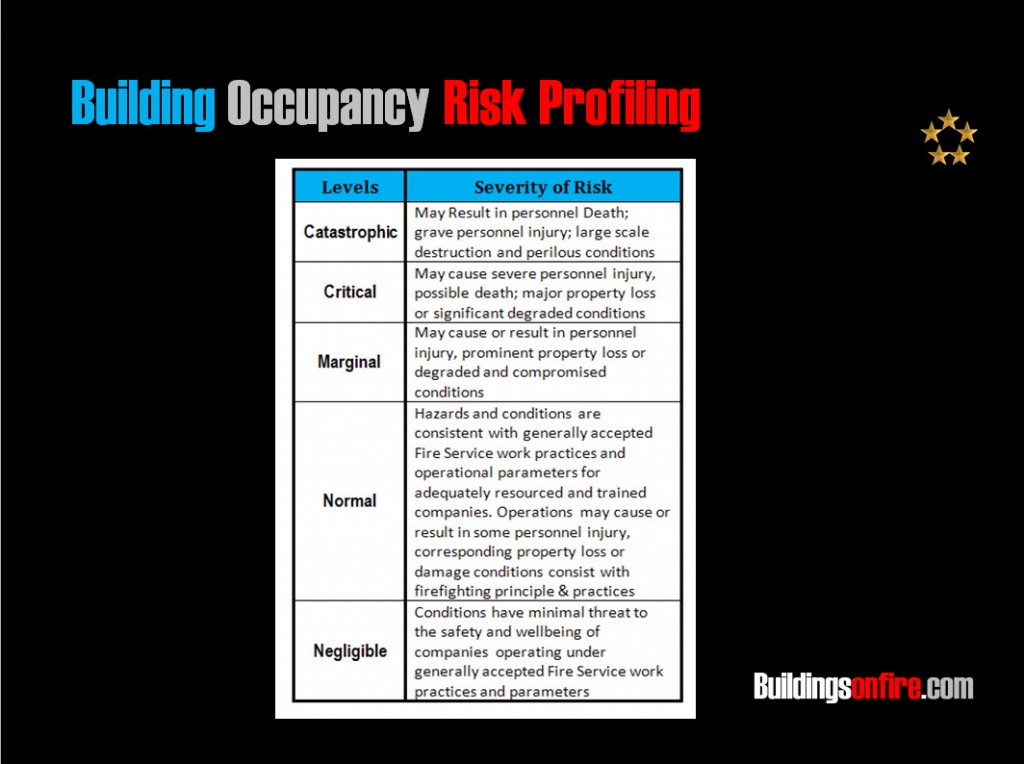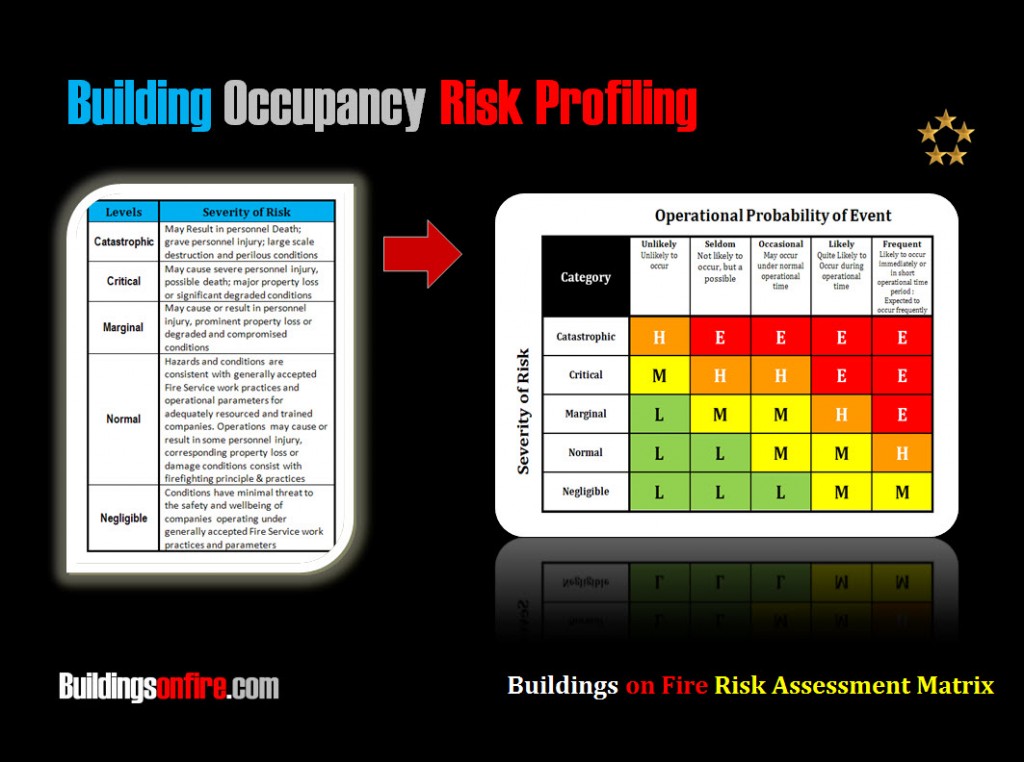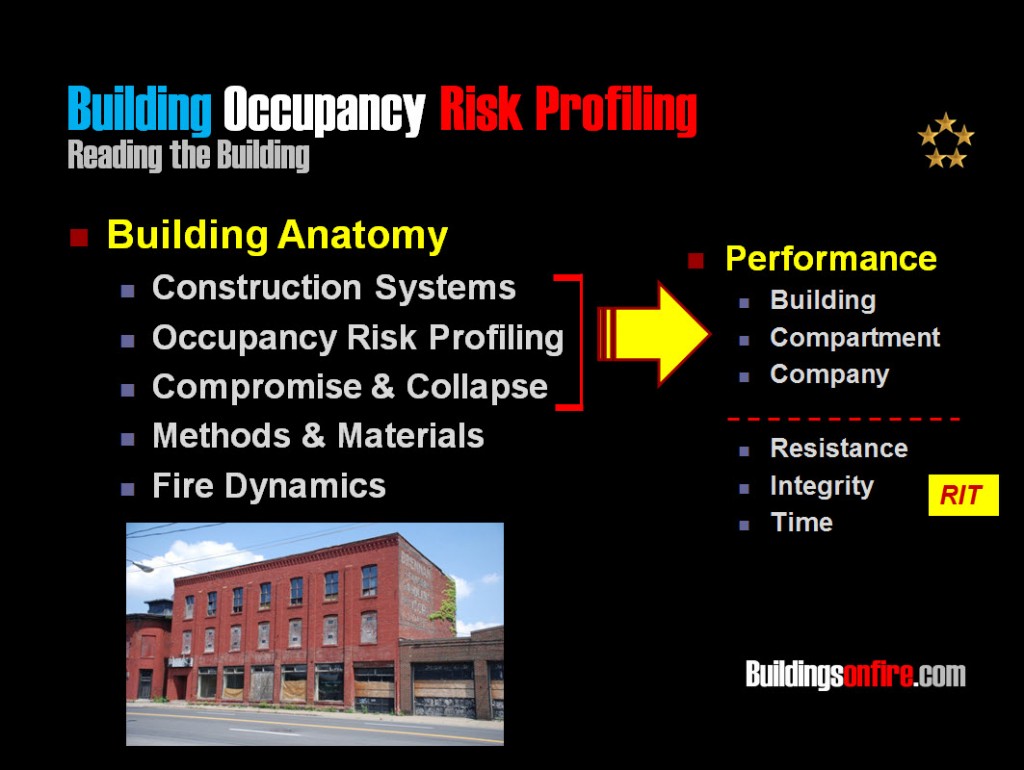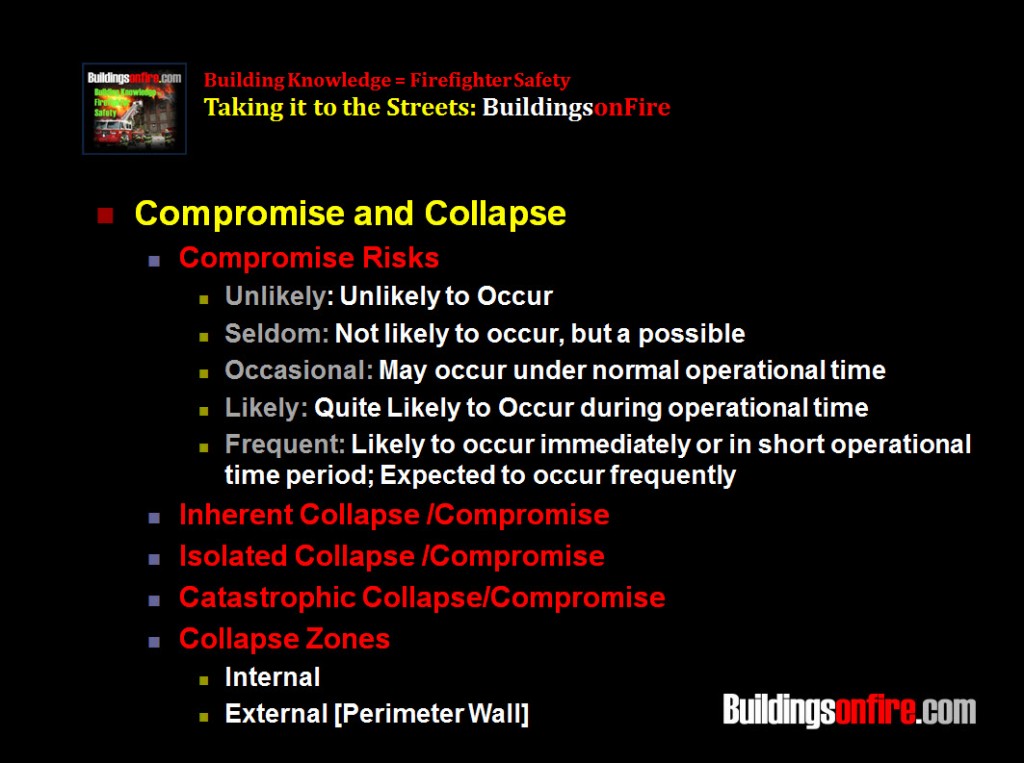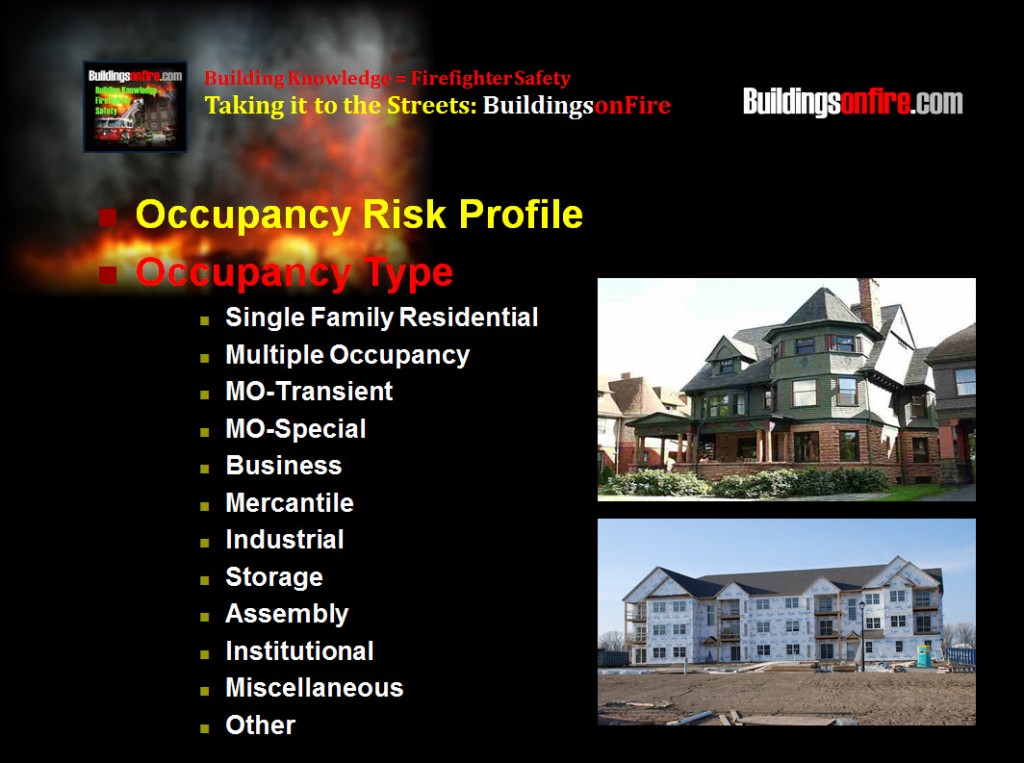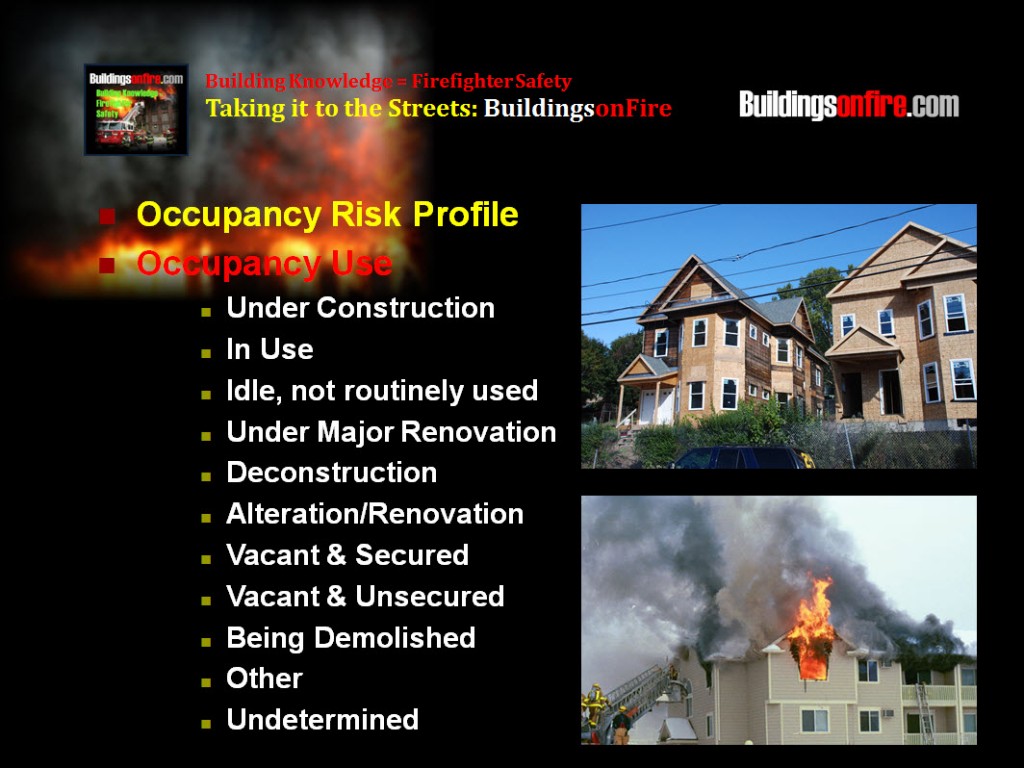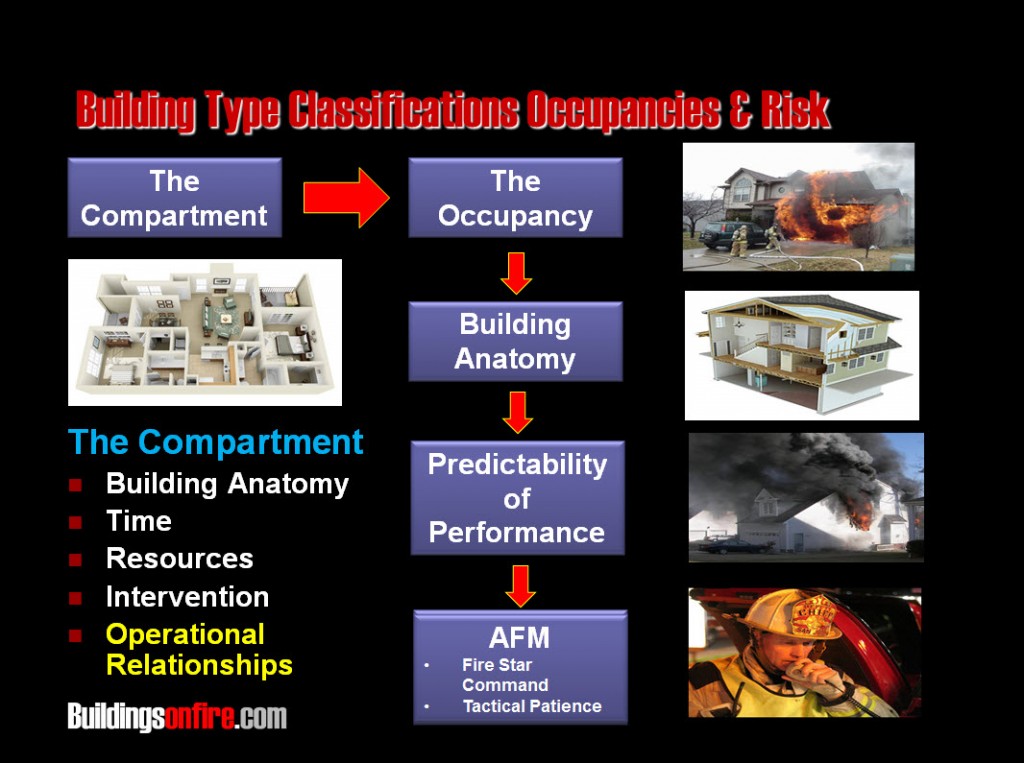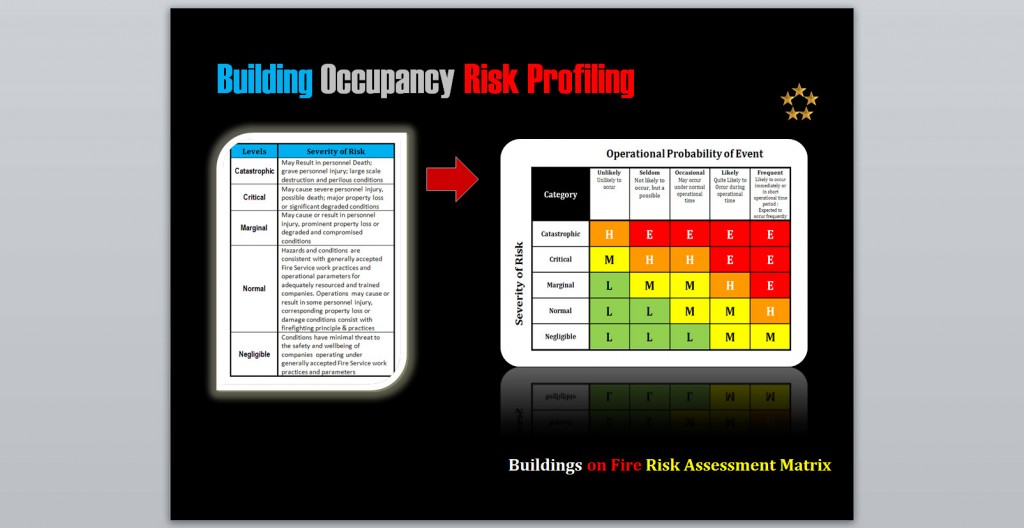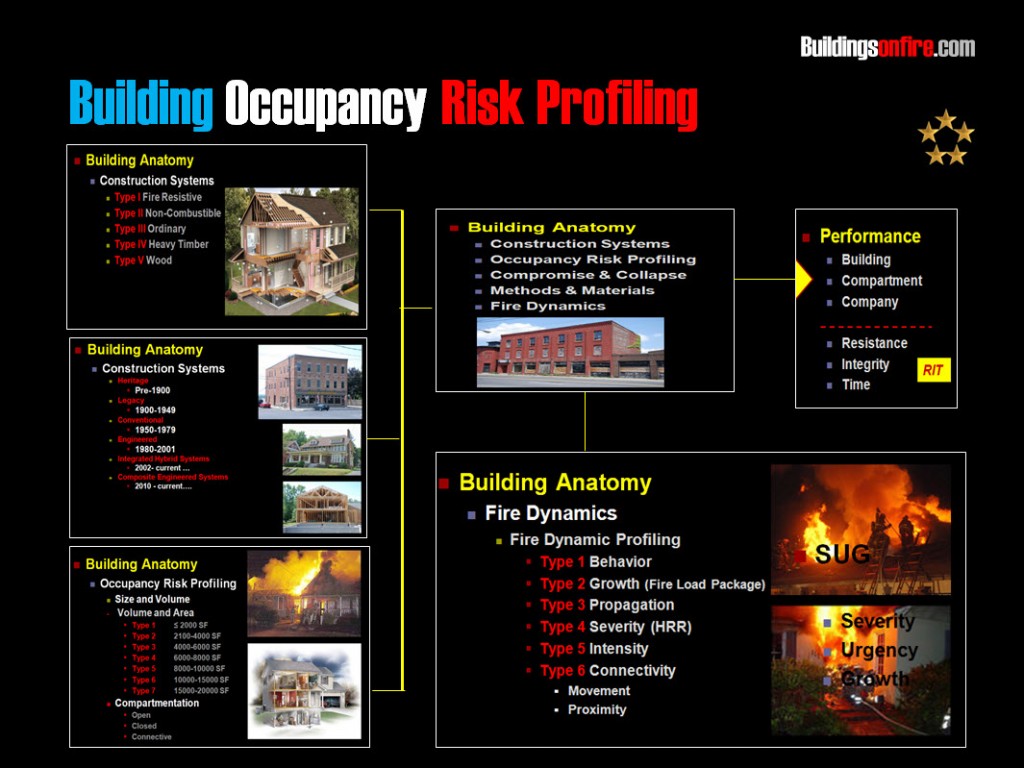Buildings on Fire Risk Assessment Matrix
By Christopher J. Naum, SFPE on Apr 25, 2019 with Comments 0
Buildings on Fire Risk Assessment Matrix Building Occupancy Risk Profiling
Reading the Building
The importance of understanding a building’s anatomy, its occupancy risk and compartment profile are integral to efficient and effective firefighting operations within buildings on fire and are essential for all phases of fire suppression and operational engagements.
Fundamental to these operations is the ability to accurately identify the building profile and predict how it will perform during the various stages of fire growth, correlated over time and throughout the fire suppression operational period.
Since the early 1950’s, the modern fire suppression performance model utilized in the U.S. Fire Service has continued to apply the referral of a building type and its occupancy classification to dictate presumptive performance and operational characteristics. Traditional Fireground operations have utilized this prescribed principle for decades, with great success.
Size-Up
First-due company and command arrivals typically define or establish prescribed strategic or tactical deployment methods based upon the predictability of fire ground and building performance indicators based up what the traditional size-up factors and indicators are being identified, perceived or assumed. Traditional sequenced and transitional size-up has been an established indispensable fireground task.
The importance of the size-up process: what is being assessed and processed, what is the level of importance of incoming indicators and information and what it means to the incident action plan and strategic and tactical process vary greatly and at times becomes superficial, minimized and non-descriptive to the point of being programmed.
I would be remised if I didn’t also evoke that there have been numerous examples of highly effective and value driven size-up practices established by organizations that have honed and developed methods, process and practices based on training and skill sets that establish this benchmark as an integral part of the fire suppression methodology model.
Notwithstanding, there are pronounced differences in the conduct of size-up from a company officer’s perspective than that of a command officer’s based upon the sequence of first-arrival. Each has distinct differences related to actions that must be considered based on incident Severity, Urgency or Growth (SUG) of the evolving incident conditions within the building and the incident actions plans (IAP) that must be formulated and implemented with regard for the continuum of time.
For example, size-up, risk assessment profiling and predictability of performance can vary greatly based on functionality and assignment. First-due engine company size-up and assessment may vary from that of the first-due truck/ladder company to that of the first-due commander or the safety officer size-up or that of the RIT/FAST Officer size-up. Protocols, risk focus areas, naturalistic decision-making attributes, situational awareness migration or drift may all influence what you are reading and interpreting when looking at the building upon arrival and as you phase into the sequence of operations.
There are numerous classic mnemonic systems that identify and address different size-up factors that can be used, which are widely referenced in strategy, tactics and incident management text books and manuals. These systems however, are no longer practical or applicable to today’s fireground, buildings, and fire dynamics and company level resource capabilities. They require recalibration and updating to reflect leading or latent indicators, variables and considerations that better align with the built environment and fireground conditions.
Our focus isn’t on debating classical size-up factors or exploring the changes necessary for effective fireground risk assessment and incident action plan formulation, which is mandated by our current fireground challenges, but rather to focus on the mission critical attribute related to the building and the dynamics of fire within the compartment and effects on the structure during the conduct of fireground operations.
Building Performance
The identification, assessment, probability, predictability and intrinsic characteristics of the building and its expected performance under fire conditions must be identified, assessed and integrated into an adaptive fire management model and flexible incident action plan.
In other words, arriving companies and personnel at a structure fire need to be able to rapidly and accurately identify key elements of a building, process that data based upon a widening field of variables present on today’s evolving fireground and implement timely actions that address prioritized actions requiring intervention. Deterministic fireground models for size-up and suppression have to give way to a more expandable stochastic model of assessment. Key to this is having a broad and well developed foundation of building knowledge.
The predictability of building performance (Naum 2005) must take into consideration that in the context of today’s fireground, buildings and fire dynamics, small changes on initial compartment or structure conditions may often produce and result in large scale or magnitude changes that affect the long term out come of the incident. Small differences may yield to widely diverging outcomes (the Butterfly Effect, Lorenz 1972).
The ability for the first arriving company, company officer or commander to perform an accurate identification of (a) building types and classifications are formulative towards anticipating variables in structural integrity and resiliency to the effects of extreme fire behavior, accelerated fire load package growth rates and intensity levels typically encountered in today’s composition and arrangement of buildings and their associated construction systems during initial and sustained fire suppression.
We have assumed that the routiness or successes of past operations and incident responses equates with predictability and diminished risk to our firefighting personnel. Our current generation of buildings, construction and occupancies are not as predictable as past construction systems, occupancies and building types; therefore the risk assessment and size-up process, and resulting strategies and tactics must adapt to address these evolving rules of combat structural fire engagement that challenge anecdotal practices and methodologies.
Today’s evolving fireground demands greater adaptive insights and management with an amplified understanding of buildings, occupancy risk profiling (ORP) and building anatomy by all operating companies on the fireground; demanding greater skill sets and knowledge of building construction, architecture, engineering, fire dynamics and fire suppression methodologies. The equation for success rests directly on Building Knowledge = Firefighter Safety.
Reading the Building
For incident deployments to a report of a structure fire, the single most important attribute that defines all phases of subsequent operations and incident management; is that of understanding the building.
An officer or commander’s skill set, comprehension and intellect in their ability to read a building is paramount towards identifying risks, conducting fluid assessment, probability, predictability and recognizing intrinsic characteristics of the building and its expected performance under fire conditions, which are essential toward development of an integrated and adaptive fire management model and flexible incident action plan.
If you don’t know and understand the building, how can you identify and select appropriate strategies and tactics and have an integrate IAP suitable for the building and occupancy risks and predictability of performance?
It’s much more than just arriving on location, indentifying a single family wood frame residential, a three story brick or a five story fireproof or single URM commercial and stretching in and going to work.
Reading the building, understanding the building’s anatomy, its occupancy risk and compartment profile are integral to efficient and effective firefighting operations within buildings on fire and are essential for all subsequent phases of fire suppression and operational engagements.
The Five Star CommandTM Model (Naum 2004) provides an integrated framework that the Adaptive Fireground Management system is based upon. Furthermore it is an essential element in the methodologies in reading a building.
Five Star CommandTM is integrated around five fundamental core domains consisting of Building Anatomy, Risk Management, Human Performance, Safety Management and Command Management. Each of these five domains also has five points of excellence that are further integrated and share functionality. The Building Anatomy domain’s five points consist of;
Building Anatomy & Construction [Five Star CommandTM ]
- Construction Systems
- Occupancy Risk Profiling
- Compromise and Collapse
- Methods and Materials
- Fire Dynamics
The following represents a brief overview of selective key operative elements that comprise the process and system of Reading the Building. They are provided in an abbreviated fashion as a primer of insights for some of the process elements and do not reflect the entire system or process.
They are provided to promote discussion and dialog and represent key focus areas of assessing and reading a building in order to identify systematic considerations, likelihood of occurrences and consequences related to key building features that are inherent to all building types and occupancies that must always be assessed that include;
Building System-Envelope
- Roof System [RF]
- Floor/Ceiling System [FL|CL]
- Floor SystemFL]
- Compartment [CP]
- Perimeter Wall [PW]
- Envelope Enclosure [EN]
Key operative elements of Reading the Building
Building Type Classifications
- Type I (or Class 1) Fire Resistive construction
- Type II (or Class 2) Non-Combustible construction
- Type III (or Class 3) Ordinary construction
- Type IV (or Class 4) Heavy Timber construction
- Type V (or Class 5) Wood Frame construction
These provide insights and have characteristics related to fire resistive ratings (hours) for Exterior Bearing Walls, Interior Bearing Walls, Columns, Beams, Girders, Trusses and Arches, Floor-Ceiling Assemblies, Roof-Ceiling Assemblies, Interior Nonbearing Walls and Exterior Nonbearing Walls and also provides a comparison of similar types of construction derived from various model building codes.
Building Anatomy & Construction
Construction Systems
Heritage Construction (HC)
- Pre-1900
Legacy Construction (LC)
- 1900-1949
Conventional Construction (CC)
- 1950-1979
Engineered Structural Systems (ESS)
- 1980-2000 Type 1
- 2001-current Type 2
Integrated Hybrid Construction Systems (IHS)
- 2002- current …
Composite Engineered Construction Systems (CES)
- 2010 – current …
Integrated into the categorization of Building Anatomy & Construction system profiles are inherent characteristics, features, process, form and function that define the buildings anatomical and operational enhancements or detriments that will influence operational actions of the fireground.
Building and Operational Risk Probability
- Risk Assessment-Command Engagement [RACE]
- Risk Assessment-Tactical Engagement [RATE]
- Catastrophic Risk:
- May Result in personnel Death; grave personnel injury; large scale destruction and perilous conditions
- Critical Risk:
- May cause severe personnel injury, possible death; major property loss or significant degraded conditions
- Marginal Risk:
- May cause or result in personnel injury, prominent property loss or degraded and compromised conditions
- Normal Risk:
- Hazards and conditions are consistent with generally accepted Fire Service work practices and operational parameters for adequately resourced and trained companies. Operations may cause or result in some personnel injury, corresponding property loss or damage conditions consist with firefighting principle & practices
- Negligible Risk:
- Conditions have minimal threat to the safety and wellbeing of companies operating under generally accepted Fire Service work practices and parameters
- Unlikely: Unlikely to Occur
- Seldom: Not likely to occur, but a possible
- Occasional: May occur under normal operational time
- Likely: Quite Likely to Occur during operational time
- Frequent: Likely to occur immediately or in short operational time period ; Expected to occur frequently
Occupancy Risk Profiling
- Occupancy Type
- Single Family Residential
- Multiple Occupancy
- MO-Transient
- MO-Special
- Business
- Mercantile
- Industrial
- Storage
- Assembly
- Institutional
- Miscellaneous
- Other
- Occupancy Use
- Under Construction
- In Use
- Idle, not routinely used
- Under Major Renovation
- Deconstruction
- Alteration/Renovation
- Vacant & Secured
- Vacant & Unsecured
- Being Demolished
- Other
- Undetermined
- Occupancy Load
- Number and Location
- Mobility, Distress or Incapacitated
- Accessibility
- Occupancy Risk
- Volume and Area
- Type 1 ≤ 2000 SF
- Type 2 2100-4000 SF
- Type 3 4000-6000 SF
- Type 4 6000-8000 SF
- Type 5 8000-10000 SF
- Type 6 10000-15000 SF
- Type 7 15000-20000 SF
- Volume and Area
- Compartmentation
- Open
- Closed
- Connective
- Accessible
- Condition
- New
- Aged
- Deteriorated
- Compromised
- Dilapidated
- Marginal
- Unsafe
- Compromise and Collapse
- Collapse Risk
- Unlikely: Unlikely to Occur
- Seldom: Not likely to occur, but a possible
- Occasional: May occur under normal operational time
- Likely: Quite Likely to Occur during operational time
- Frequent: Likely to occur immediately or in short operational time period ; Expected to occur frequently
- Systems
- Roof [RF]
- Floor/Ceiling [FL|CL]
- Floor [FL]
- Compartment [CP]
- Perimeter Wall [PW]
- Enclosure [EN]
- Compromise Risks
- Unlikely: Unlikely to Occur
- Seldom: Not likely to occur, but a possible
- Occasional: May occur under normal operational time
- Likely: Quite Likely to Occur during operational time
- Frequent: Likely to occur immediately or in short operational time period ; Expected to occur frequently
- Inherent Collapse /Compromise
- Isolated Collapse /Compromise
- Catastrophic Collapse/Compromise
- Collapse Zones
- Internal
- External [Perimeter Wall]
- Methods and Materials
- Resistance
- Resiliency
- Integrity
- Modular
- Monolithic
- Time Impacts
- Fire Dynamics
- Fire Dynamic Profiling
- Type 1 Behavior
- Type 2 Growth (Fire Load Package)
- Type 3 Propagation
- Type 4 Severity (HRR)
- Type 5 Intensity
- Type 6 Connectivity
- Movement
- Proximity
Predictability of Performance
- Building
- Compartment
- Company
The increasing variables related to building construction, design, materials and methods of construction, process and workmanship, occupancy types, risks, compartment characteristics, functionality and use, fire behavior, adaption, renovation, age and deterioration coupled with the continuous evolving fire suppression capabilities of a department and agency demands new process and systems that align with current and future operational fireground demands providing a readily accessible and retrievable process that adds value in the performance and conduct of critical steps in the management and suppression of a structure fire in a building and occupancy.
The evolving and rapidly changing dynamics of building structures and occupancies both in terms of new construction as well as the renovation and adaptive reuse of older buildings and occupancies are self revealing that suggests alternatives and improvements in what and how we view a building now and how we can better read them in the future to take advantage of information that can be presumed, predicted or known.
Providing a new order in identification and assertion, with the predictability of building and occupancy performance during fire suppression operations may provide the edge we need in the challenges faced on today’s evolving, adaptive and risked induced fire ground. We just need to read the building with clarity and knowledge.
Buildings on Fire Risk Assessment Matrix
Buildings on Fire Risk Assessment Matrix Building Occupancy Risk Profiling
Filed Under: Predictive Occupancy Performance • Theory & Models
